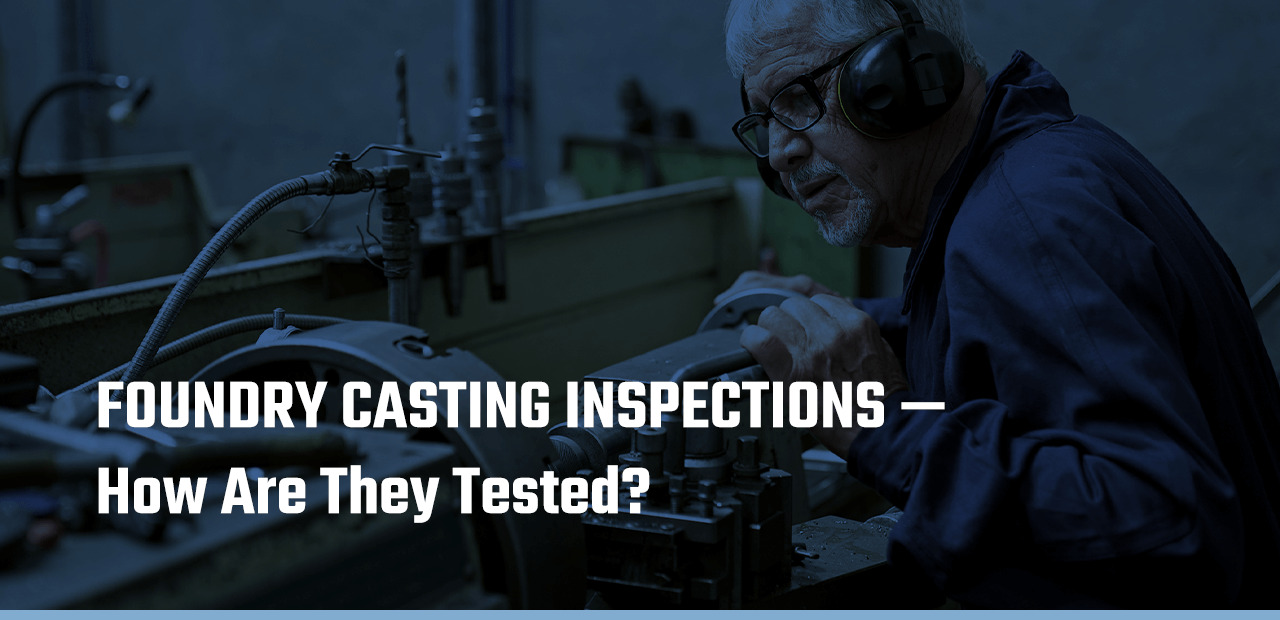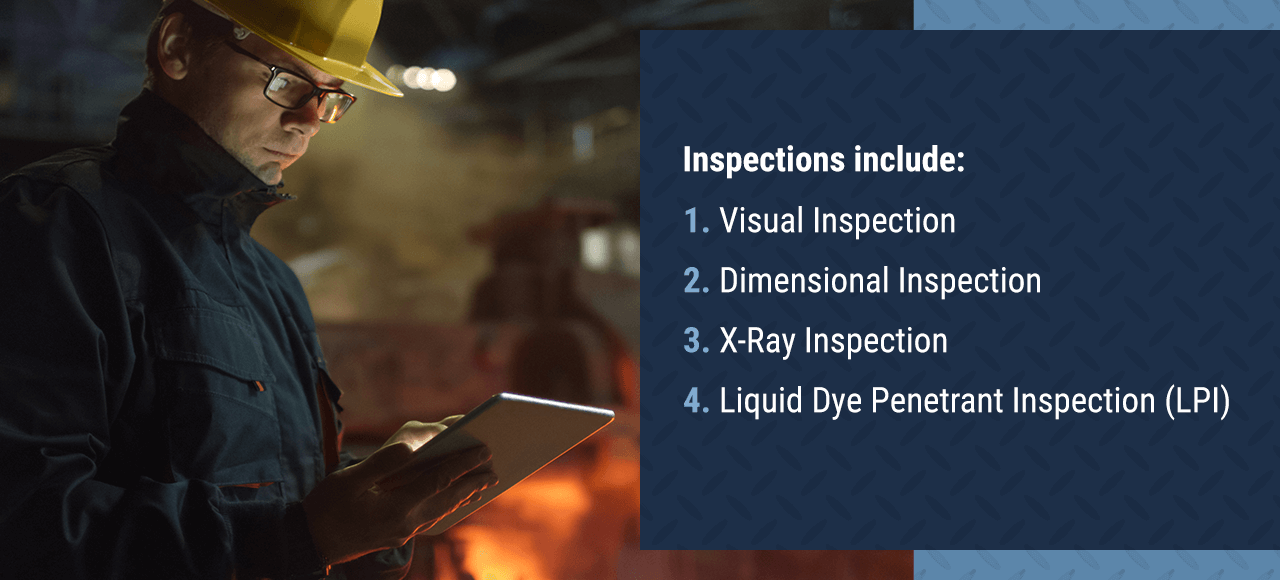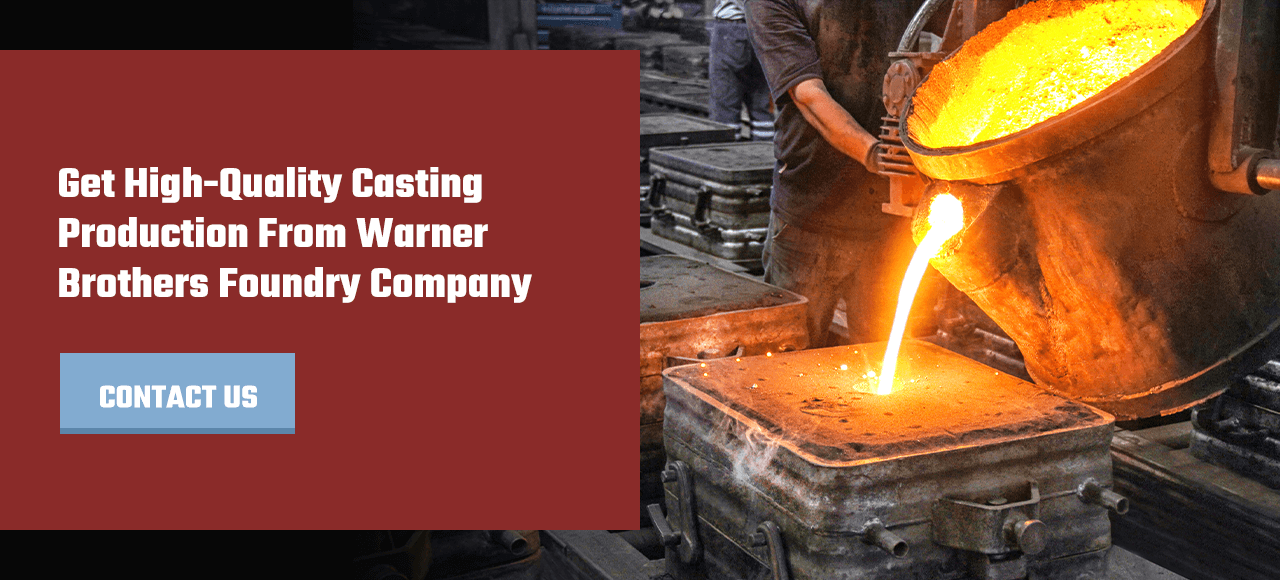Successful production of a quality casting varies depending on the control of the casting operation and the testing and inspection that follows. The metal casting facility takes on the responsibility for quality, which begins with the raw materials selected, but the supplier and customer agree on which critical part and process variables are included. This impacts what testing and inspections are needed.
Businesses that need non-ferrous castings want orders to withstand the test of time, including frequent use, working conditions and environmental elements that can cause wear and tear on the castings’ metal components. At Warner Brothers Foundry Company, we can complete non-destructive testing procedures and create metal casting products within our facility.
Is Casted Metal Inspected?
Yes, casted metal gets inspected. Inspections for casting are essential for avoiding issues with the finished metal casting’s surface finish, soundness, financial dimensions and mechanical properties. Even when the metal casting process is performed carefully, castings should still be inspected to ensure quality control. Castings can have mechanical requirements undermined by a hidden defect, and small issues can arise unexpectedly. Foundry product inspections allow clients and foundry to be confident they have a quality casting.
Casting Inspection Checklist
During the manufacturing process, methods of casting inspection are put in place to identify hidden defects. A few common casting issues include cooling, inclusion and surface defects. Beyond destructive and non-destructive testing, there are several inspection steps:
- Destructive testing: When the foundry chooses samples and submits them to destructive testing, the metal’s properties are closely inspected after the casting is cut. The tester examines the metal for shrinkage, porosity and inclusions. Though this testing doesn’t provide guarantees regarding the other castings, it gives a sense of the process’s overall quality. Though this form of testing is used to make evaluations about the run and inspect the quality, ultrasonic and radiographic technologies have decreased its importance.
- Non-destructive testing (NDT): True to its name, this type of testing does not harm the metal materials during inspection. Foundry workers, technicians and clients perform non-destructive testing to verify the casting’s external and internal soundness without damaging the casting. The process of non-destructive testing involves placing a metal material under high-stress conditions for quality control. This testing varies depending on the type of alloy selected. For every type, this testing can identify deterioration or imperfections across the metal surface.
The inspections castings go through ensures they are equipped for the customer’s needs and tasks. Inspections include visual, dimensional, X-ray and liquid dye penetrant inspections.
1. Visual Inspection
The visual inspection involves using the human eye to detect surface defects, tears, misruns, cracks, cold shuts, gas evolution, molding flaws, metal penetration, slag adhesions and sand inclusions. This inspection is essential to ensure the casting adheres to visual acceptance standards. Inspection results should be documented and recorded, and every surface irregularity should be classified. Any castings with visually detected defects should be picked out and not delivered to customers.
At Warner Brothers Foundry Company, we use magnifying glasses to examine metal castings and digital systems to identify premature cracks.
2. Dimensional Inspection
The dimensional inspection ensures a part of the casting meets dimensional requirements or tolerances. This inspection can be performed manually or via a coordinate measuring machine (CMM) that utilizes probes for precise measurements. CMM is the most accurate way of testing the products’ dimensions.
3. X-Ray Inspection
An X-ray inspection of the castings can ensure they meet a quality standard. X-rays can reveal small breaks, crevices of heat cracking and shrinkage cavities. Cracks, inclusions and voids will display as a dark area due to the radiation the X-ray uses. If a casting’s mechanical properties have been compromised by holes, inclusions or shrinkage, the item can be fixed before shipment. In some cases, common surface irregularities may not affect the use of the otherwise sound casting.
4. Liquid Dye Penetrant Inspection (LPI)
With a liquid dye penetrant inspection (LPI), small surface imperfections like pores or cracks that are hard to see in metal castings are identified. First, the tester cleans the casting to eliminate dust or grit that could prevent the liquid dye from getting into the metal’s cracks.
After the metal is clean and dry, it is bathed with a penetrant solution. Different solutions are used depending on the type of LPI used, though the solution is typically an oil with low viscosity and high capillary action, which allows it to flow freely into the casting’s cracks. This dye is given dwell time to work into invisible crevices. Eventually, the excess is removed with a damp cloth. After a special developer is applied, casting defects are clearly visible.
Casting Inspection Standards
The inspection is the final step in the metal casting process. During this step, Warner Brothers Foundry Company ensures everything is up to the proper standards. The inspection ensures the part’s integrity and physical structure will perform the expected job. Depending on the casting’s specifications, the destructive or non-destructive testing methods will be used. We inspect a wide range of items from small automotive parts to industrial equipment and make sure you have a durable component that meets your unique operational needs.
We’re looking at the quality of the castings, which means we’re examining the levels of mechanical properties and degrees of soundness. In some cases, the casting may fail the inspection for not meeting the standards. Some common causes of casting inspection failures include:
Faulty Product
Casting will not meet inspection standards if it has one or more of the following faults:
- Fusion
- Drops
- Misruns and run out
- Slag inclusion
- Metal penetration
- Hot tear or crack
- Hot or hard spots
- Open or closed shrinkage defects
- Subsurface blowhole
Physical Defects
Physical defects impact performance and longevity. Examples include:
- Pinholes
- Warping or swelling
- Open holes
- Cold shut or shot
- Cuts and washes
- Shifting or mismatch
- Burrs, fin and flash
- Buckles, veins and rat tails
Get High-Quality Casting Production From Warner Brothers Foundry Company
Look to Warner Brothers Foundry Company for high-quality casting production and non-destructive testing of your castings. We have been providing quality and excellent service to our customers since 1955. To identify the most effective alloy depending on your casting application, you can trust our experienced staff. We can find the solution for you, regardless of whether you need castings for production or prototype.
At Warner Brothers Foundry Company, we are a full-service bronze, brass and aluminum casting foundry. We service every industry that requires cast products, and our non-destructive testing ensures you will be completely satisfied. For every non-ferrous casting application, we are the best choice. Contact us at Warner Brothers Foundry Company or learn more about our services today.




